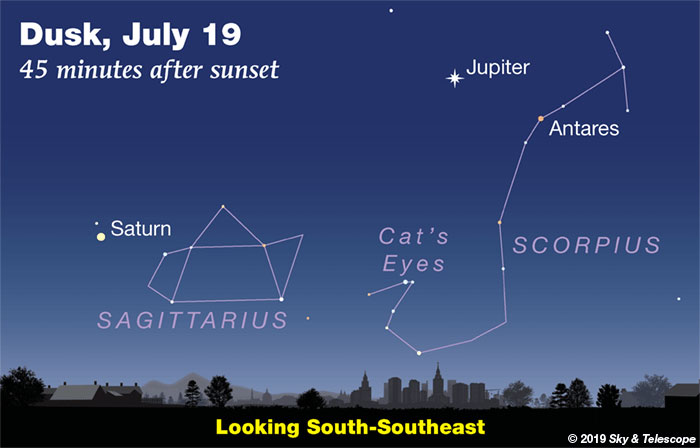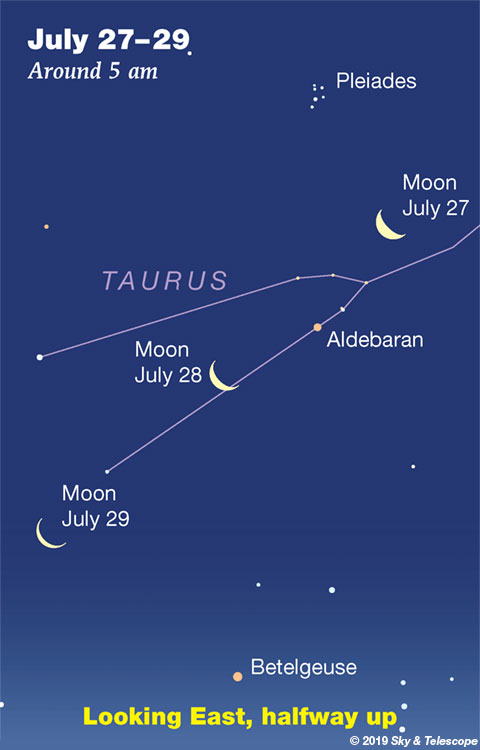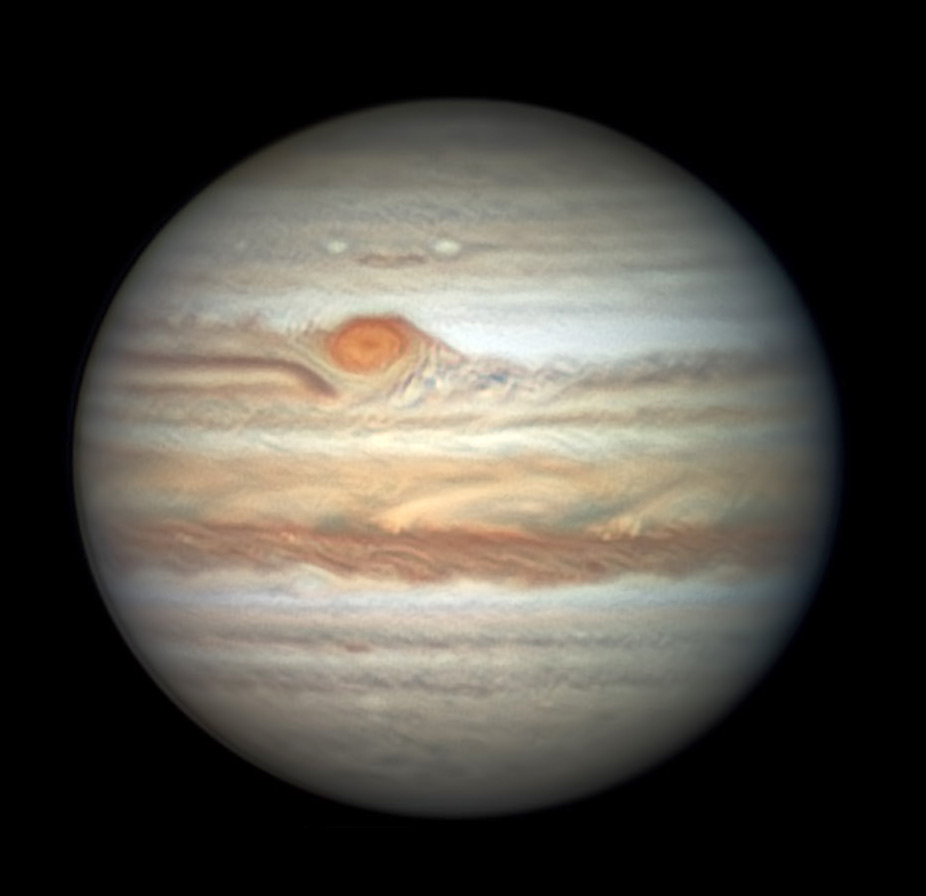
Friday, July 19
• The tail of Scorpius is low due south after dark, as shown above. How low depends on how far north or south you live: the farther south, the higher.
Look for the two stars especially close together in the tail. These are Lambda and fainter Upsilon Scorpii, known as the Cat's Eyes. They're canted at an angle; the cat is tilting his head and winking.
The Cat's Eyes point to the right by nearly a fist-width toward Mu Scorpii, a much tighter pair (shown as a single dot on the map) known as the Little Cat's Eyes. They're oriented almost exactly the same way as Lambda and Upsilon. Are your eyes sharp enough to resolve the Mu pair without using binoculars? Not many people can!
Saturday, July 20
• Scorpius is sometimes called "the Orion of Summer" for its brightness, its blue-white giant stars, and its prominent red supergiant (Antares in the case of Scorpius, Betelgeuse for Orion). But Scorpius passes a lot lower across the south than Orion does, for those of us at mid-northern latitudes. That means it has only one really good evening month: July.
Catch Scorpius due south just after dark now, before it starts to tilt lower toward the southwest. It's full of deep-sky objects to hunt with a sky atlas and binoculars or a telescope.
• Once the Moon does rise, contemplate the moment 50 years ago today when a man took the first step onto another world. The sunset terminator tonight is approaching Tranquillity Base, and everything there must be casting long shadows.
Sunday, July 21
• After nightfall, Altair shines in the east-southeast. It's the second-brightest star on the eastern side of the sky, after Vega very high to its upper left. Above Altair by a finger-width at arm's length is little orange Tarazed.
A bit more than a fist-width to Altair's left or lower left is little Delphinus, the Dolphin, leaping leftward.
Above the midpoint between Altair and Delphinus is even fainter little Sagitta, the Arrow.
Monday, July 22
• Got a really dark sky? Or planning to vacation under one? The Milky Way arches high across the eastern sky now — from Perseus and Cassiopeia low in the north-northeast, across Cygnus and through the Summer Triangle high in the east, and down through Sagittarius and the tail of Scorpius low in the south.
Bring a low-power, wide-field scope for some grand star fields. And for an unusual excursion, bring the July issue of Sky & Telescope to hunt out some of the spooky dark nebulae in Ophiuchus over Jupiter — using Richard Wild's "Going Deep" column and chart starting on page 57.
Tuesday, July 23
• Week by week, bright Arcturus is losing some of its height in the west after dark.
Look for Spica lower left of Arcturus by about three fists at arm's length. Lower right of Arcturus by the same amount is Denebola, tailtip of Leo. These three stars form a nearly perfect equilateral triangle.
Wednesday, July 24
• Last-quarter Moon (exact at 9:18 p.m. EDT). The Moon rises late tonight, around midnight or 1 a.m., way down below Andromeda and Pegasus in the east.
Thursday, July 25
• With the advance of summer, the Sagittarius Teapot is in the south these evenings (to the lower right of Saturn). It's starting to tilt and pour from its spout to the right. The Teapot will tilt farther and farther for the rest of the summer — or for much of the night if you stay out late.
Friday, July 26
• Bright Vega now passes closest to overhead around 11 p.m., depending on how far east or west you live in your time zone. How closely it misses your zenith depends on how far north or south you are. It passes right through your zenith if you're at latitude 39° north (Washington DC, Cincinnati, Kansas City, Lake Tahoe). How closely can you judge this just by looking?
Deneb crosses closest to the zenith almost exactly two hours after Vega.

• Cold-weather preview: Before the beginning of dawn on Saturday morning the 27th, you'll find the waning Moon hanging nearly between Aldebaran and the Pleiades, stars that are more familiar in the evening sky of late fall and winter.
The "5 a.m." on the chart here applies only if you're close to your time zone's standard longitude. In any case, wherever you are, your best time — with the most stars — will be just before dawn begins: as much as two hours before your local sunrise.
Saturday, July 27
• We're not yet halfway through summer, but already W-shaped Cassiopeia, a constellation of fall and winter evenings, is climbing up in the north-northeast as evening grows late. And the Great Square of Pegasus, emblem of fall, comes up to balance on one corner over the eastern horizon.
________________________
Want to become a better astronomer? Learn your way around the constellations. They're the key to locating everything fainter and deeper to hunt with binoculars or a telescope.
This is an outdoor nature hobby. For an easy-to-use constellation guide covering the whole evening sky, use the big monthly map in the center of each issue of Sky & Telescope, the essential guide to astronomy.

Once you get a telescope, to put it to good use you'll need a detailed, large-scale sky atlas (set of charts). The basic standard is the Pocket Sky Atlas (in either the original or Jumbo Edition), which shows stars to magnitude 7.6.
Next up is the larger and deeper Sky Atlas 2000.0, plotting stars to magnitude 8.5; nearly three times as many. The next up, once you know your way around, are the even larger Interstellarum atlas (stars to magnitude 9.5) and Uranometria 2000.0 (stars to magnitude 9.75). And read how to use sky charts with a telescope.
You'll also want a good deep-sky guidebook, such as Sue French's Deep-Sky Wonders collection (which includes its own charts), Sky Atlas 2000.0 Companion by Strong and Sinnott, or the bigger Night Sky Observer's Guide by Kepple and Sanner.
Can a computerized telescope replace charts? Not for beginners, I don't think, and not on mounts and tripods that are less than top-quality mechanically (meaning heavy and expensive). And as Terence Dickinson and Alan Dyer say in their Backyard Astronomer's Guide, "A full appreciation of the universe cannot come without developing the skills to find things in the sky and understanding how the sky works. This knowledge comes only by spending time under the stars with star maps in hand."
This Week's Planet Roundup
Mercury, Venus, and Mars are out of sight in the glare of the Sun. Mercury will be back in view in the dawn come August, but Venus and Mars are basically gone until October.

Jupiter (magnitude –2.5, in southern Ophiuchus) is the white point glaring in the south during and after dusk. Orange Antares, much fainter at magnitude +1.0, twinkles 7° to Jupiter's lower right.
Jupiter and Antares form a wide, shallow, isosceles triangle with Delta Scorpii (Dschubba) to their right. Delta, a long-term eruptive variable of the Gamma Cassiopeiae type, has been not much fainter than Antares for most of the last 19 years — after it brightened by some 50%, without warning, in July 2000.
In a telescope Jupiter is shrinking just a little, from 44 to 43 arcseconds wide this week. See Bob King's observing guide to Jupiter.
Saturn (magnitude +0.1, in Sagittarius) is the steady, pale yellowish "star" in the south-southeast after dark, 31° east (left) of Jupiter. Look to Saturn's lower right for the Sagittarius Teapot.
In a telescope Saturn's rings are tilted a wide 23° to our line of sight, not quite as open as they've been for the last couple of years.
Uranus (magnitude 5.8, in Aries) is high in the east before the first beginnings of dawn.
Neptune (magnitude 7.8, in Aquarius) is high in the south at that time. Finder charts for Uranus and Neptune.
_________________
All descriptions that relate to your horizon — including the words up, down, right, and left — are written for the world's mid-northern latitudes. Descriptions that also depend on longitude (mainly Moon positions) are for North America.
Eastern Daylight Time (EDT) is Universal Time (UT, UTC, GMT, or Z time) minus 4 hours.
_________________
Audio sky tour. Out under the evening sky with your earbuds in place, listen to Kelly Beatty's monthly podcast tour of the heavens above. It's free.
_________________
“This adventure is made possible by generations of searchers strictly adhering to a simple set of rules. Test ideas by experiments and observations. Build on those ideas that pass the test. Reject the ones that fail. Follow the evidence wherever it leads, and question everything. Accept these terms, and the cosmos is yours.”
— Neil deGrasse Tyson, 2014
______________________
 2
2








Comments
Jakob
July 20, 2019 at 4:50 am
No charts when clicking the link for the two outer planets. Just page not found!
You must be logged in to post a comment.
Jakob
July 22, 2019 at 2:04 pm
Thank you for the charts
You must be logged in to post a comment.
You must be logged in to post a comment.